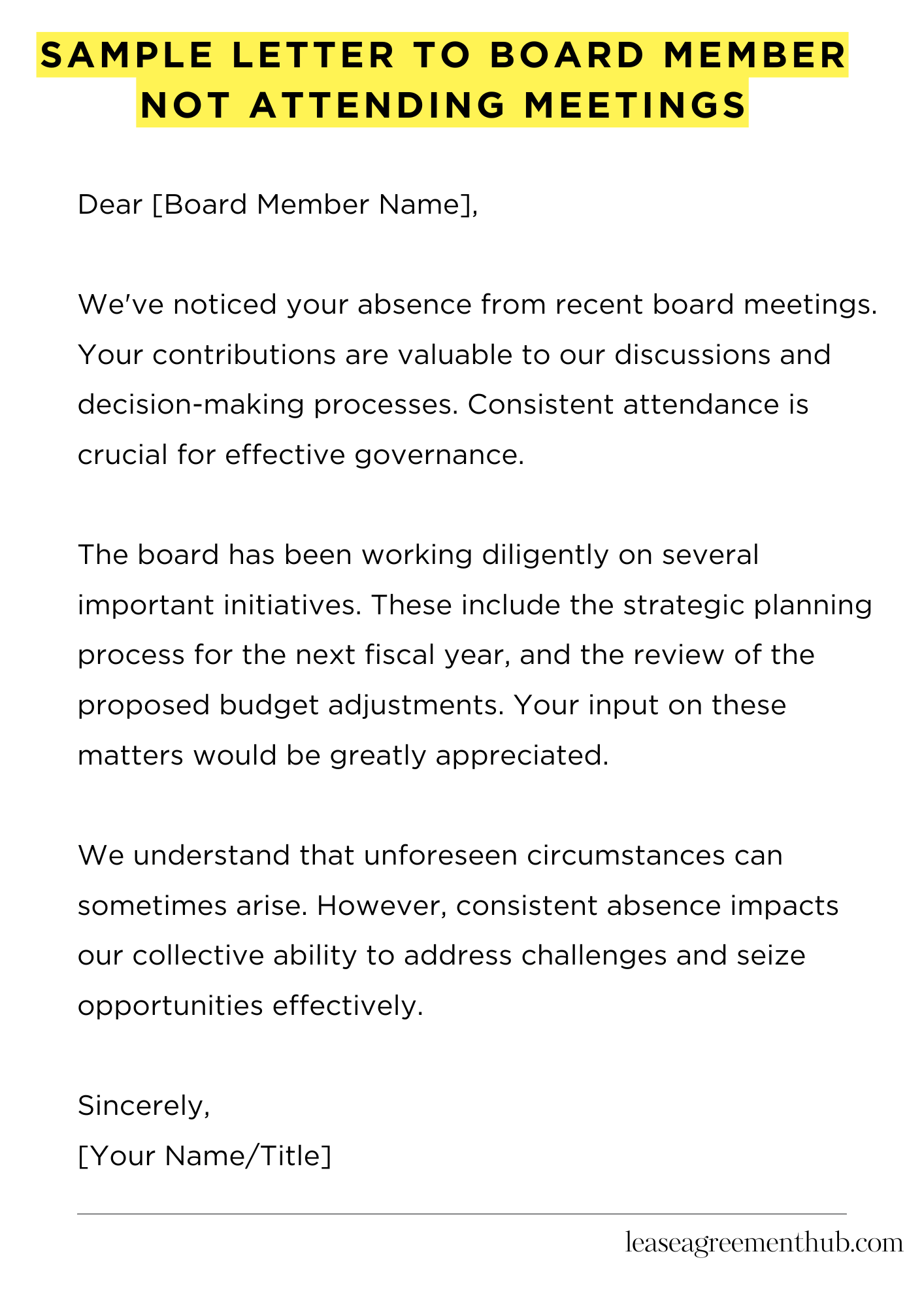A “sample letter to a board member not attending meetings” is a template designed to address the issue of absenteeism in board meetings. Its purpose is to communicate concerns regarding the board member’s absence and encourage their participation. These letters highlight the importance of their role and the impact of their absence on the board’s function. They serve as a formal reminder of their responsibilities and express the need for their active involvement.
In this article, we will provide you with various templates and examples of such letters. These samples are crafted to help you effectively address the issue with the absent board member. By using these templates, you can save time and ensure that your message is clear and respectful. Whether you need a formal or a more casual tone, these examples will guide you in drafting the perfect letter.
Our aim is to make the process of writing these letters as straightforward as possible. With these samples, you will have a solid foundation to create a letter that suits your specific situation. This will help you maintain professionalism and encourage the board member to reengage with their duties. Let us assist you in crafting a message that is both impactful and considerate.
Sample Letter to Board Member Not Attending Meetings
[Your Name/Organization Name]
[Your Address]
[Your Phone Number]
[Your Email]
[Date]
[Board Member Name]
[Board Member Address]
Dear [Board Member Name],
We’ve noticed your absence from recent board meetings. Your contributions are valuable to our discussions and decision-making processes. Consistent attendance is crucial for effective governance.
The board has been working diligently on several important initiatives. These include the strategic planning process for the next fiscal year, and the review of the proposed budget adjustments. Your input on these matters would be greatly appreciated.
We understand that unforeseen circumstances can sometimes arise. However, consistent absence impacts our collective ability to address challenges and seize opportunities effectively. Please let us know if there are any obstacles preventing your attendance. We are happy to explore solutions to ensure your participation.
We value your commitment to [Organization Name]. Your active involvement is essential to our success. We look forward to seeing you at the next meeting.
Sincerely,
[Your Name/Title]

How to Write a Sample Letter to Board Member Not Attending Meetings
Understanding the Gravity of the Situation
Non-attendance at board meetings is a serious issue. It undermines collective decision-making, stifles progress, and can even jeopardize the organization’s legal standing. A formal letter addressing this absence is often necessary. This isn’t merely a polite nudge; it’s a crucial step in maintaining organizational efficacy.
Crafting a Salutation: Setting the Tone
Begin with a professional and respectful salutation. Avoid informality; “Dear Mr./Ms./Mx. [Board Member’s Name]” is perfectly acceptable. A less formal approach might backfire and diminish the gravity of the situation. The initial tone sets the stage for the entire communication. Remember, the aim isn’t to attack but to address a critical matter.
Articulating the Problem: Concise and Direct
Clearly state the board member’s absences and their frequency. Use quantifiable data whenever possible. For instance: “Records indicate you have missed three of the last four board meetings.” Avoid obfuscation; be direct and unambiguous. This section should leave no room for misinterpretation.
Exploring the Implications: A Measured Approach
Elaborate on the consequences of these absences. Did the lack of participation impede crucial decisions? Did it lead to delays or inefficiencies? The ramifications should be meticulously detailed to underscore the seriousness of the situation. This section necessitates a precise and measured approach, avoiding hyperbole.
Offering Solutions and Seeking Resolution
Propose solutions to address the attendance issue. Is there an underlying reason for the absences? Perhaps a schedule conflict or personal impediment is at play. Offer potential accommodations or alternative communication methods, demonstrating a willingness to collaborate. This conciliatory approach fosters a more productive dialogue.
Concluding with a Call to Action: A Clear Expectation
Conclude by requesting a response within a specified timeframe. This sets a clear expectation and encourages prompt action. End with a professional closing, such as “Sincerely,” or “Respectfully,” followed by your name and title. The concluding paragraph should succinctly reiterate the urgency of the matter.
Maintaining Professionalism: A Paramount Consideration
Throughout the letter, maintain a professional and respectful tone. Even if frustration exists, avoid accusatory language. The goal is to encourage future attendance, not to instigate conflict. A measured and professional approach is paramount in resolving this challenging situation. Remember, the organization’s success hinges on the active participation of all its board members.
FAQs about sample letter to board member not attending meetings
What is the purpose of writing a letter to a board member about missed meetings?
The purpose is to formally document the absences, express concern about their impact on the board’s effectiveness, and encourage future attendance or provide an opportunity to explain the absences.
What information should be included in the letter?
The letter should clearly state the number of meetings missed, the dates of those meetings, and express concern about the impact on the board’s work. It should also invite the board member to explain the absences and discuss potential solutions for improved attendance.
What tone should the letter adopt?
The tone should be professional, concerned, and constructive. While expressing concern, it should avoid being accusatory or confrontational, aiming for a collaborative approach to resolving the attendance issue.
Should the letter be sent by email or traditional mail?
While email is often quicker, a formal letter sent via traditional mail might be considered more appropriate for its gravitas, depending on the organization’s culture and the severity of the attendance issue.
What should the letter’s closing aim to achieve?
The closing should reiterate the importance of board member participation and express a willingness to work with the board member to find a solution. It should also specify a timeframe for a response or a follow-up meeting.
Related: